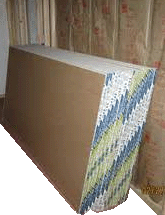|
The Hazard of Upright Drywall Stacks
 Just before the first drywall sheet is hung, there is a brief period of time when framing is complete, mechanicals are in place and every outlet and wire is in full view. Just before the first drywall sheet is hung, there is a brief period of time when framing is complete, mechanicals are in place and every outlet and wire is in full view.
Contractors, customers, inspectors and architects along with various trade and service professionals, can be found at the project site. They come to measure, inspect, approve and verify that no detail is overlooked before the walls are obscured by drywall. And this is the time when jobs are typically stocked with drywall.
Stocking methods vary by structure, floor plan, job circumstance, geography and local customs. The merits of laying sheets flat vs. placing sheet upright has been debated for years with no consensus between parties who manufacture, distribute and install drywall. One faction believes drywall should always be laid flat while the other insists there is an unnecessary ergonomic impact for workers who deliver and install drywall. When stockers are required to place sheets on the floor and installers must then lift sheets off the floor, the repetitive action can take a physical toll on the musculoskeletal system.
In a perfect world, all drywall deliveries would be made to a level site, with easy access and all work done by hydraulic equipment – but this is not the real world of construction.
One fact that is not in dispute, drywall is delivered and placed upright on jobs all across North America during every work day. How do we warn and protect people who come in contact with upright drywall stacks and who have no knowledge of the potential harm they may encounter?
Drywall professionals know that pulling a stack forward is hazardous; but most people do not! A vertical stack of drywall does not have an obvious appearance of danger and does not necessarily merit the attention and caution one would give climbing a stair with no railing or avoiding close proximity to an unguarded opening in a floor. This is just one reason that people will stand close enough to a stack without realizing the hazard and be struck by falling drywall when someone else causes the stack to become unstable. Another cause of drywall accidents occurs when people who do not understand the weight of drywall and pull it forward to check and outlet, wire or something else that is behind the drywall stack.
How does this disconnect between perceived weight vs. actual weight of the sheets occur? Ten sheets of drywall placed on the floor, would be virtually impossible to lift all at once – yet a vertical stack can be pulled forward one sheet at a time with minimal effort.
A stack weighing a thousand pounds, when tipped over, will gain momentum as it falls. By the time it reaches the floor, the force will reach 6,000 pounds. When drywall is delivered to the job and placed upright against a wall, special precautions must be taken. Drywall sheets placed on edge should always be secured against tipping and with a restraint method that can be easily reapplied. The stack should also be labeled with a warning or caution sign that states the potential danger of attempting to move heavy drywall sheets.
There are multiple benefits of stocking drywall upright. However, significant hazards can be created with this process if precautions are not taken. Incidental or accidental drywall stack tip- over can result in life changing injuries or death. We know that securing and placing a warning label on each stack of vertically stacked drywall results in a safer worksite and protects everyone who may be in the proximity of the stack. In order to keep all people safe from the hazard of falling drywall, more national, regional and local contractors have begun to require edge stacked drywall to be secured as part of the drywall subcontractor’s scope of work.
The Division of Occupational Safety and Health (OSHA) protects workers from health and safety hazards on the job in almost every workplace. OSHA by regulation may issue a citation and or penalty for unsecured drywall stacked on edge.
Here at Brookstone Builders we want everyone to go home safely every day and we are committed to doing our part to make that happen.
After all, excellence is never an accident!
|